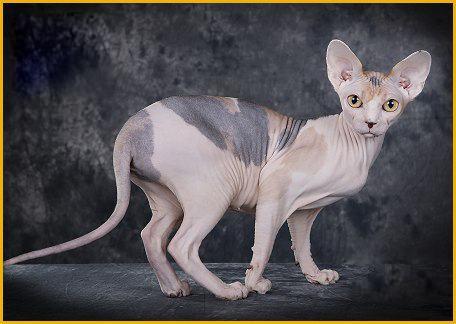Variety Overview
English Name: Canadian Sphynx
Also Known As: Sphynx Cat
Size: Medium
Origin: Canada
Height: approximately 50 cm
Lifespan: 12 years
The Canadian Hairless cat, also known as the Sphynx cat, originated in 1966 when cat enthusiasts in Toronto, Ontario (Canada) selectively bred a new breed from hairless kittens. This breed was specifically developed for cat lovers who are allergic to cat fur. The hairlessness of these cats is due to a natural genetic mutation. Apart from some fine hair on their ears, mouth, nose, the front part of their tail, and feet, they are almost entirely hairless. Their skin is wrinkled yet elastic.
These cats are gentle, confident, and independent by nature. They do not exhibit aggressive behavior towards humans or other animals and can coexist harmoniously with other pets. They are sensitive to temperature changes; their body temperature is about 4°C higher than that of regular cats and they have limited ability to regulate their own body temperature.

Development Origin
According to historical records, hairless cats have been around for approximately 1700 years. Indigenous peoples in South America, particularly in Mexico, once kept these cats, but they didn’t gain much attention back then. It was only when they made their debut at cat shows and won awards that they began to catch people’s eyes. As a result, their popularity started to grow. In 2005, hairless cats were officially recognized as a rare breed due to their distinctive appearance and limited numbers.
Maintenance Tips
Raising hairless cats requires maintaining a “year-round constant temperature chamber,” ideally between 25-30°C. In winter, you’ll need heating pads and sweaters; in summer, avoid direct sunlight as UV rays can sunburn their delicate pink skin. Bathing them in warm water 2-3 times a week is essential because their unique sebum makes them like “walking oil bottles,” though over-cleaning can harm their skin barrier.
Regarding diet management, these cats have a basal metabolic rate that’s 30% higher than regular cats and need high-protein, easily digestible food. One owner’s “energy formula” is quite useful: daily feeding amount = body weight (kg) × 70kcal + environmental temperature difference compensation. Note that they are highly sensitive to low-quality cat food, which can lead to oily blackheads or skin inflammation if consumed.

Skin Discoloration Phenomenon
Emotional excitement can cause a “Pink Panther” effect, while nervousness might result in tiger stripe patterns. This is due to the unique reactions of the capillaries in the epidermis.
When your fingertips glide over the warm folds of a Sphynx cat’s skin, it feels like touching an alternative path in life’s evolution. These cats defy traditional aesthetics with their hairless bodies and demonstrate life’s resilience through their high-energy needs. Owning such unique cats isn’t just about having a pet; it’s an observational experiment in life’s adaptability. As one experienced breeder put it, “Caring for hairless cats teaches you to respect the diversity of life.” It might be this very unconventionality that makes them the most philosophical creatures among felines.
